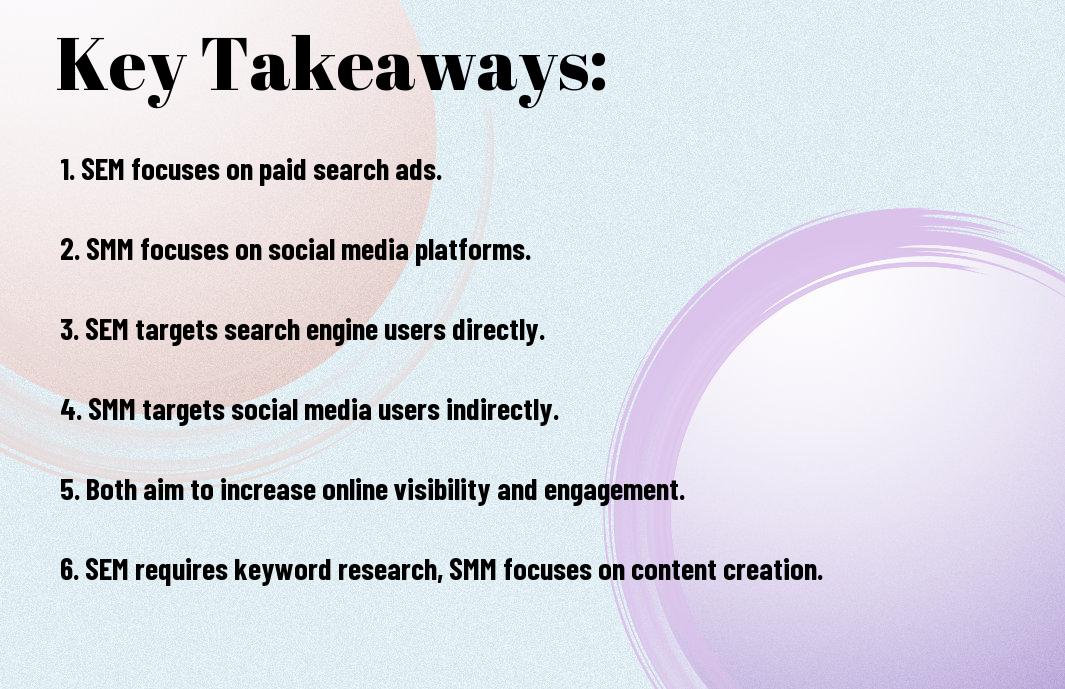It’s crucial to have a clear understanding of the variances between Search Engine Marketing (SEM) and Social Media Marketing (SMM) to maximize their benefits effectively. SEM primarily focuses on paid advertising on search engines to increase visibility and drive traffic to a website via paid search listings. On the other hand, SMM involves organic and paid strategies to create engaging content and campaigns on various social media platforms to boost brand awareness and foster customer engagement. While both are powerful digital marketing tools, understanding their unique differences and functionalities is necessary for businesses to create a well-rounded online presence.
Key Takeaways:
- SEM (Search Engine Marketing) focuses on paid advertising to gain visibility on search engine results pages.
- SMM (Social Media Marketing) involves organic and paid efforts on social media platforms to build brand awareness and engage with target audiences.
- SEM targets search engines like Google, Bing, and Yahoo, while SMM focuses on social media platforms such as Facebook, Instagram, Twitter, and LinkedIn.
Overview of SEM (Search Engine Marketing)
Definition and Purpose
With the exponential rise in online searches and the increasing competition for visibility on search engine results pages, Search Engine Marketing (SEM) has become a vital digital marketing strategy for businesses. The primary purpose of SEM is to enhance a website’s visibility on search engines through paid advertising methods.
Key Components of SEM
Engineered to bring immediate results, SEM encompasses various critical components. Advertising campaigns, keyword research, ad groups, ad copy creation, bid management, and landing page optimization are vital elements within SEM.
A successful SEM strategy involves selecting relevant keywords that target the right audience, creating compelling ads that stand out among competitors, strategically managing bids to maximize ROI, and optimizing landing pages to drive conversions. These components work in synergy to propel a brand’s visibility and drive quality traffic to their website.

Overview of SMM (Social Media Marketing)
Understanding SMM and its Goals
With the rise of social media platforms, Social Media Marketing (SMM) has become an vital part of digital marketing strategies. SMM focuses on utilizing social media channels to connect with the target audience, increase brand awareness, drive website traffic, and generate leads.
Core Elements of SMM
With the diverse range of social media platforms available, SMM includes various core elements such as creating engaging content, developing a social media strategy, analyzing and monitoring metrics, and engaging with followers. These elements are crucial for building a strong online presence and connecting with customers effectively.
For instance, creating engaging content that resonates with the target audience is vital for driving user engagement and increasing brand visibility. Additionally, analyzing and monitoring metrics helps marketers to track the performance of their social media campaigns and make data-driven decisions to optimize results. Engaging with followers by responding to comments and messages in a timely manner helps to build a loyal community around the brand.
Comparing SEM and SMM
Unlike SMM and SEM: What Is The Difference That You Need To …, the comparison between Search Engine Marketing (SEM) and Social Media Marketing (SMM) is crucial for digital marketers seeking to optimize their online presence. Each strategy has its unique benefits and applications, which can greatly impact a brand’s online success.
Differences in Platforms and Approaches
One notable difference between SEM and SMM lies in the platforms and approaches used. SEM focuses on paid advertising on search engines like Google, targeting keywords to reach specific audiences actively searching for products or services. On the other hand, SMM involves creating engaging content on social media platforms such as Facebook, Twitter, and Instagram to build brand awareness and engage with followers.
Budgeting and Cost Implications
Budgeting for SEM and SMM can vary significantly based on the platform and campaign objectives. The budget for SEM typically involves bidding on keywords and pay-per-click models, where costs can escalate based on keyword competitiveness and ad placement. Meanwhile, SMM costs are often more flexible, focusing on content creation, community management, and influencer collaborations, allowing for a wider range of budget options depending on the brand’s goals.
Synergy between SEM and SMM
Integrating SEM and SMM for Enhanced Marketing
On combining Search Engine Marketing (SEM) and Social Media Marketing (SMM) strategies, businesses can create a comprehensive marketing approach that leverages the strengths of both channels. By integrating SEM, which focuses on paid advertising and search engine visibility, with SMM, which centers around engaging with audiences on social platforms, companies can increase brand visibility and drive targeted traffic to their websites.
Best Practices for Utilizing Both Strategies
The synergy between SEM and SMM can be maximized by coordinating keyword targeting across search and social platforms, aligning messaging to maintain brand consistency, and utilizing cross-platform retargeting to reinforce brand presence. Creating a cohesive marketing strategy that integrates both SEM and SMM efforts can lead to higher conversion rates and improved return on investment.


To wrap up
The key difference between SEM and SMM lies in their core focus and strategies. Search Engine Marketing (SEM) centers around paid advertising to boost a website’s visibility on search engine result pages through strategies like pay-per-click (PPC) campaigns. On the other hand, Social Media Marketing (SMM) involves leveraging social platforms to engage with audiences, build brand awareness, and drive website traffic through organic and paid means. Understanding these distinctions is crucial for businesses aiming to create a comprehensive digital marketing strategy that maximizes their online presence and connects with their target audience effectively.
FAQ
Q: What is the difference between SEM and SMM?
A: Search Engine Marketing (SEM) involves paid advertising to increase a website’s visibility in search engine results pages. This includes strategies such as pay-per-click (PPC) ads. On the other hand, Social Media Marketing (SMM) focuses on promoting content and engaging with audiences on social media platforms through both organic and paid means.
Q: How do SEM and SMM differ in terms of targeting?
A: SEM allows for precise targeting based on keywords and demographics, reaching users actively searching for specific products or services. SMM, on the other hand, offers targeting options based on user interests, behaviors, and demographics, allowing for more personalized and engaging content delivery on social platforms.
Q: What are the key metrics used to measure the success of SEM and SMM campaigns?
A: For SEM, key metrics include Click-Through Rate (CTR), Cost Per Click (CPC), Conversion Rate, and Return on Ad Spend (ROAS). In SMM, important metrics are Engagement Rate, Reach, Clicks, Shares, and Conversion Rate. Both SEM and SMM strategies can be optimized based on these metrics to drive better results and achieve marketing goals.



